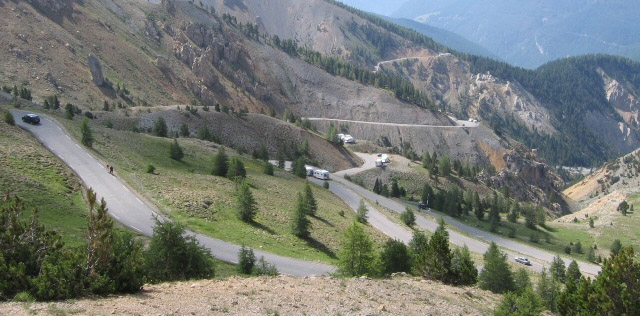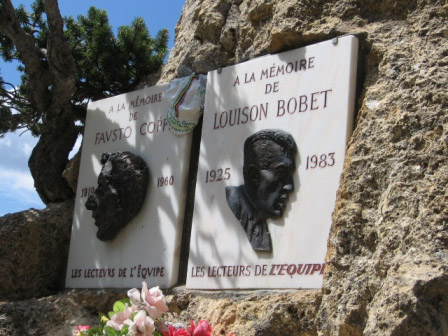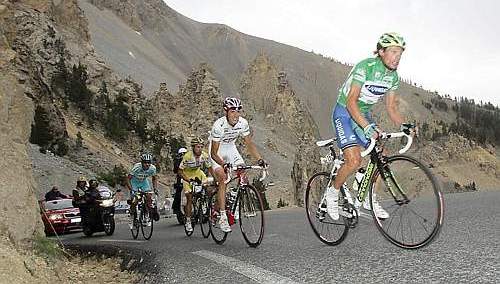CyclingRevealed's Giro '07 Perspective
Tappa 12, May 24th, Scalenghe to Briancon (France), 163 km
"Killer" on the Loose! 

Spectacular view from the Cima Coppi on the Colle dell'Agnello (2,744m)
We have had sprinter's days, we have had ‘piano' days and we have also tasted some excellent climbing days but today is something else altogether! The Giro may not be won today but amongst the pretenders to the Giro throne, there will be those who will absolutely lose the race. In 163.5kms of racing there are about 65kms of climbing. And this is no ordinary climbing.
The race starts easily enough with about 60kms of flat roads before starting the ascent of the mighty Colle dell'Agnello. At 2744m (9101ft) this climb is one of the highest in Europe and is the highest point in this year's Giro (and therefore designated as the Cima Coppi). First used by the Giro in 1994, Fausto Coppi never raced on this road but he would certainly appreciate the enormous majesty of this challenge. In all, the climb is about 40kms long with ramps of 15% along the way. The final 10kms, in rarified air, passes over a barren landscape far from any civilization and the gradient is seldom less than 10%. Just over the summit the road passes across the border from Italy into France and then starts a long descent towards the Col d'Izoard.

The second climb of the day the Col d'Izoard
The 2360m Col d'Izoard, in terms of cycling history, is quite the opposite of the Colle dell'Agnello. Cycling history and legends are etched along this climb which was first used in 1922. Writers will use every superlative in the dictionary in describing the exploits that have been played out along this road. When you ride this climb you feel the spirit of champions past in this amphitheater of incredible natural beauty.
Coming at the Izoard from Italy the Giro actually cuts off about half of the classic climb typically used by the Tour. This in no way means that the riders have an easier day. For most, the Colle dell'Agnello would have turned their legs to mush. And if that did not do the job then the descent on to the Izoard through icy mountain air would have exacerbated their pain by seizing up the muscles. At the base of the descent the road, which is now on the flank of the Izoard, immediately rises up again through rugged mountain scenery.
The road junction spilling the Giro onto the Izoard came at the area above the very long gorge that rises dramatically up from Guillestre (and is the traditional Tour approach). Here a plateau of idyllic high mountain pastures carries the road up a deceptive ‘false flat' through the village of Arvieux . When I rode this way I had been so motivated by the grandeur of the climb up from Guillestre that I had ridden much too aggressively. The dead straight road over the pastures through Arvieux nearly put paid to my day. The interminable drag seemed to put lead weights onto my pedals. At one point I felt as though my knees would explode!
At the far end of this road you can see it disappear into what seems a vertical wall of rock blanketed in hardy Alpine pine trees. Somehow I made it to the forest and immediately the road reared up towards the first of about ten sharp hairpin bends. Joyfully I discovered what we often see with Grand Tour riders on the big climbs, my legs came back and I powered up the road with the agony of the Arvieux plateau now just a nasty memory. The change in gradient, and the frequent out-saddle-efforts created a very different effort to the interminable grind that I had just endured. When you actually experience this you understand how dropped Grand Tour riders are able to apparently recover on long climbs.
This forest of pines and its hairpin bends tops out at what looks like a summit and immediately a very different world appears. The road suddenly drops for about 1/2km into the famous Casse Desert which is a barren landscape that could be taken for a moonscape. On the short descent a natural rock pillar on the riders left carries a marble plaque with bronze busts of Fausto Coppi and Louisan Bobet to remind everyone of the epic rides that these roads have seen.

The Coppi/Bobet Memorial on the Izoard
Almost immediately the brief descent is over and the road climbs again. Rapidly the final challenge comes into view as a series of nasty looking hairpins take the road up to the bleak summit. Over the top the road plunges down into another pine forest on well made roads. After all the climbing the sudden speed necessitates acrobatic skill to stay on the road. Now, arms that have been pulling for so long respond unhappily to this new effort. Going down, especially in a race, can be as hard as going up!
The mountain road soon gives way to the outskirts of Briançon which is Europe 's highest city at 1327m. To the uninformed (as I was on my first ride here) you swoop down through the city streets exhilarated at having conquered the great climbs. On race day you simply follow the roadside barriers to what you believe will be the finish along some nice boulevard. Unexpectedly in the middle of town the road suddenly turns sharp right and you are in fact facing a long boulevard. However this road harbors the final horror of the day as it rises up to the fortress that dominates the town. When I came this way my ride companions told me that the road goes up and around the fortress walls before hitting a final cobbled climb of 1.5kms rearing up 14% to the finish. Not for me, I turned and found a nice café for some French pastry and coffee!
What to do? Both Simoni and Garzelli have experienced this lethal combination of a Agnello/Izoard day followed by a mountain ITT the next day. Too much effort the first day will drain the tanks for the next and, as Simoni and Garzelli have demonstrated along these roads in the past, this is where a Giro can be lost.
Perhaps knowing this recent Giro history the bunch (and especially the GC contenders) refrained from any heroics on the way to the Agnello climb. However there are always some lesser riders willing to chance their luck and at 14kms Christophe Riblon (Ag2r) and Yoann Le Boulanger (Bouygues Telecom) slipped off the front. By the time that they reached the base of the Agnello they had pulled away by 18 minutes. Ten kms from the summit Boulanger rode away alone and scooped up the prestigious Cima Coppi award. The ‘real race' however had turned into a slaughter house as the Giro peloton exploded into tiny groups and individual riders trying to survive the purgatory of the mountain. Di Luca, Schleck, Piepoli, Cunego and Mazzoleni now comprised the elite chase group as they crested the summit 5m 58s down on Boulanger. Behind them Garzelli had been on and off as he came along a further minute back.

The elite group powers over the Izoard ( Image © La Gazetta )
On the long chilly descent a lot of regrouping took place. Garzelli reconnected with the elite group who, in turn, were still chasing the lone leader. More significantly Marzio Bruseghin (who was now challenging for the Maglia Rosa) was with another small group and getting closer to the Di Luca group. The Maglia Rosa himself (Andrea Noe) was having a tough day and was now out of contention.
On to the Izoard and Boulanger was still bravely fighting on in solitary splendor. The riders quickly passed through Arvieux and its pastures to reach the wooded climb ahead. Simoni looked the most aggressive and tried several times to forge ahead alone. His accelerations put paid to Garzelli and also put Cunego in trouble. These efforts also caused the gap to Boulanger to be closed down (he had been in the lead for 130kms). Young Andy Schleck from Luxembourg (and the only non-Italian in the group) rode a very intelligent race and confidently contained Simoni's efforts. Out of the forest, past the Coppi/Bobet memorial, and now it was time for the final assault to the summit. With just 1.5km to the top Di Luca let loose a “killer” attack to summit just ahead of the others. Cunego was already in trouble but the others were not throwing in the towel. Over the top and down the long sinuous descent Di Luca was brought to heel as Cunego managed to reconnect.
Di Luca, Simoni, Schleck, Mazzoleni and Cunego were now in the streets of Briançon. Into the narrow winding streets of the fortress passing over cobbled alleys, narrow bridges and dodging around fortified buildings, it came down to a Di Luca/Simoni duel. Putting in a massive effort Di Luca just managed to hold off Simoni with Schleck nicely ahead of the rest for third place.
"Killer" on the Loose! ( Image © La Gazetta )
Noe came home 9m 40s (along with Bettini) after Di Luca and happily passed the Pink mantle over to his teammate. Based on what we saw today Di Luca and Simoni are the strong men of this race. We should see a raging battle between the Liquigas and Saunier Duval troops in the coming days. But tomorrow they are all on their own as the time trial will confirm who has it and who is cooked.
While Di Luca and Simoni came out on top today there are still plenty of possibilities for riders like Schleck, Cunego, Bruseghin and Arroyo and a few others to artfully steal the show. However they all know that now there is a real “killer” on the loose!
Tomorrow: 12.6kms of sheer agony as the riders tackle a nasty individual mountain time trial from Biella to Santuario di Oropa. This will definitively create further clarification on the GC pecking order.
Return to Giro 07 ToC >>> Previous Stage >>> Next Stage >>> |
